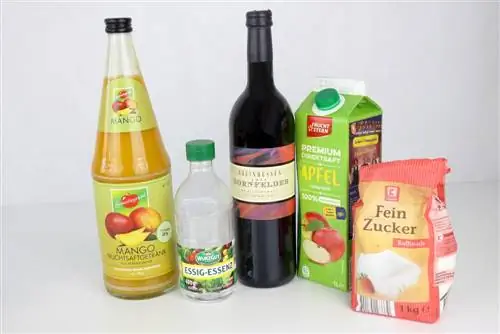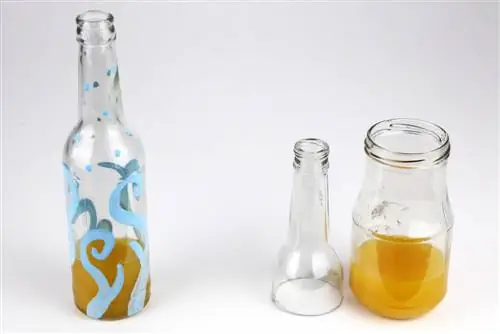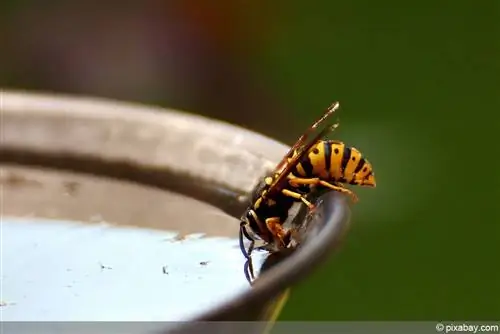- Author admin [email protected].
- Public 2023-12-17 03:39.
- Last modified 2025-01-24 12:45.
In summer, people like to sit outside on the terrace, balcony and garden. Of course, a number of drinks and food are also consumed here. But these in turn attract uninvited guests, such as annoying wasps, which many people are afraid of. But with a glass bottle as a wasp trap and the right attractants, the animals don't even get close.
Prepare glass bottle
PET bottles are often mentioned when it comes to wasp traps. However, these often do not look decorative and could therefore be disruptive, for example at a party or when sitting comfortably together. This doesn't happen with glass bottles that also look like decorations. A bottle with a thin, long neck should be used for this. This prevents the wasps from finding their way out of the bottle. This bottle can be prepared as follows:
- paint if desired
- use colorful bottles like green or brown
- Wrap the wire around the neck of the bottle
- leaving a longer loop at the top
- Bottles can be hung like this
- distribute decoratively on a large balcony or terrace without wire
- place between plants
- Attractant can only be filled in liquid form
If you have manual skills, you can also cut off the neck of the bottle with a glass cutter. Sand both interfaces well so that they do not pose a risk of injury. Then fill in the attractant and place the neck of the bottle upside down again in the lower part of the bottle. This means the wasps no longer have a chance to escape. Place near the seat but still far enough away.
Tip:
Since wasps should not be killed and useful insects such as bees could also be caught in the trap, it should be checked regularly. The animals that get lost can then be released far from where they sit.
Set up a wasp trap
The wasp trap should be placed at least two meters away from the dining table. Otherwise the annoying animals will choose the easier route and end up in the glass or on the well-filled plate. It should also be borne in mind that when setting up traps with attractants, they usually smell so good to wasps that animals are attracted even from far away. It can happen that more wasps come than are actually in the garden. The following should also be taken into account when setting up glass bottles as wasp traps:
- dying wasps send out messenger substances
- these signal danger to their fellow species
- other nearby wasps can react so aggressively
- Never place traps near allergy sufferers or children
Tip:
Since there is a risk that wasp traps will attract more people, they should not be used on small balconies. Here it is better to cover everything that could attract the annoying animals and bring it straight back into the house after enjoying it.
Attractant with vinegar

To prevent bees or bumblebees from ending up in the wasp trap, vinegar should be added to every attractant, because neither bees nor bumblebees like this smell. However, wasps are still attracted to this. To fill the glass bottle with an effective mixture, here is the appropriate attractant recipe:
- 4 tablespoons sugar
- 200 ml fruit juice, apple or orange juice ideal
- 200 ml wheat beer
- 6 cl vinegar
- put all ingredients in separate bottle
- shake well so that everything is mixed well
- then fill the wasp trap with this cocktail
Tip:
To prevent the wasps from drowning, you should not fill the liquid too high in the container. Avoid adding detergent, this reduces surface tension and the wasps would quickly drown.
Easy Lure Recipe
A simple sugar mixture can also be effective, but sometimes the wasps are already so spoiled that it takes more than just sugar and water to attract the animals. As a rule, a recipe with several ingredients such as beer, juice and sugar is better for keeping the annoying insects away from the table, which also has delicious smelling and tempting food. The second, simple recipe therefore looks like this:
- 6 tablespoons sugar
- 1 1/2 cups water
- If there are bees in the garden, also add 1/2 cup of vinegar
Tip:
The more ingredients that are attractive to the wasps in the attractant, the more likely they are to fly to the trap and leave the coffee or lunch grill table alone.
Attractant recipe with juice
If you don't want to waste beer, you can make a mixture without the good barley juice. Of course, fruit juice can also be used; apple juice is usually recommended here. This recipe looks like this:
- 1 1/2 cups apple juice
- alternatively you can also use orange juice
- 3 tablespoons sugar
- put in separate bottle
- Shake well and fill into wasp trap
It won't be quite as sweet and sticky if half of the juice is filled up with water. This mixture also helps to lure the annoying wasps into the trap.
Recipe with red wine
Red wine is also a good attractant for wasps, who especially like the sweet varieties. If a nice evening with friends is on the agenda, where red wine is also offered, a small part of it can end up in the wasp trap. The recipe for this looks like this:
- one part red wine
- one part water
- If using dry red wine, add three tablespoons of sugar
- mix well and fill into trap
Tip:
In a very old recipe from grandmother's times, the red wine is mixed in equal parts with raspberry syrup instead of water and sugar.
Attractant recipe with honey
As an alternative to sugar, honey can also be used in the attractant. This magically attracts wasps, but bees are also often lured into a trap by honey, which should actually be avoided. Therefore, the recipe with honey looks like this:
- fill separate bottle one third with vinegar
- Add two to three tablespoons of honey
- shake well
- Pour mixture into wasp trap
The added vinegar deters bees and bumblebees from flying into the trap, while wasps are attracted by the honey.
Solid attractants

Solid attractants can be used in a glass bottle with the neck cut off and reinserted upside down. Because they can be so easily trapped. The main advantage of the solid attractants is that the wasps can no longer find their way out of the trap but also cannot drown. This is a gentle method and the animals can be caught and released far away from the garden. Solid attractants include:
- a piece of overripe fruit
- sliced apple or pear
- peeled oranges
- sliced peaches or apricots
- is grilled, can attract a piece of raw meat
- Wasps also like salmon
- a very expensive alternative
Cleaning wasp traps
Wasp traps should be cleaned well regularly. However, this is relatively easy with glass bottles. These are simply emptied. Depending on whether there are live specimens in the trap, they are released far away from the garden. The attractants are disposed of in the residual waste or in the sink. Then clean the traps as follows:
- hold entire glass bottle under water
- Add dishwashing liquid
- shake well
- rinse well with water
- no residue of detergent should remain
- turn upside down to dry
- Pull the neck out of the lower part of the cut bottle
- proceed carefully so that the glass does not break
- release live wasps
- Clean the bottle and bottle neck well with detergent
The cut glass bottle is even easier to clean than the bottle that remains whole. Both clean well and without odor and can be stored in the cupboard or storage room until the next use.
Wasps like it sweet
The wasps native to our latitudes, the common wasp and the German wasp, are especially wild about everything sweet. Because the queens have to survive the next winter so that a new colony can be formed next year. The worker wasps are therefore primarily responsible for procuring food for their queen. It is therefore important that the wasps find plenty of energy-rich food for their queen. Therefore, wasp traps in which there is a lot of sugar in the attractants are particularly helpful in keeping the annoying animals away from the house, garden and terrace.

